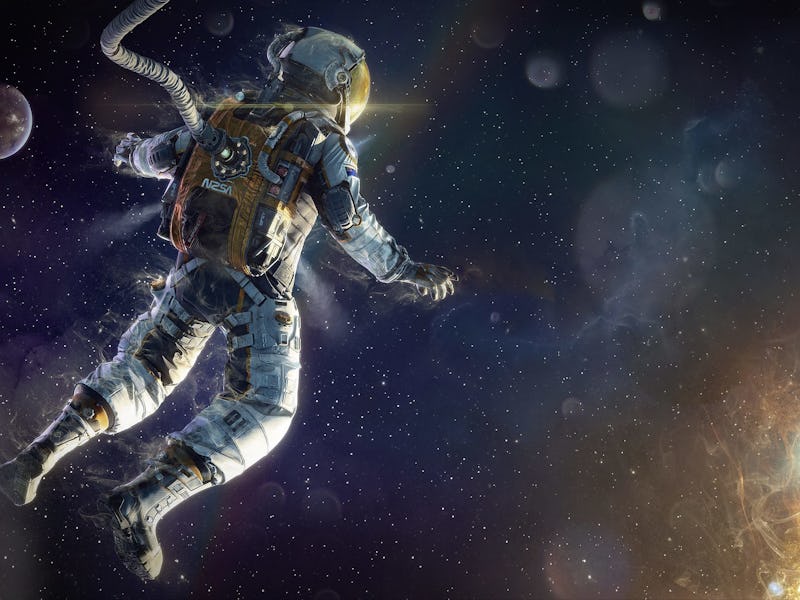Exercise in Space is a Complicated Necessity
The effects of microgravity aren't pretty.

In space, unlike on Earth, one can’t just hop on a treadmill and go for a run. And extraterrestrial sloth compounds pre-existing conditions of orbital spread. The havoc that microgravity wreaks on the human body is pretty dreadful: Symptoms include bone density loss, muscle atrophy, the flattening of eyeballs which creates impaired vision, decreased blood pressure thanks to a change in heart shape, and many more. The more time astronauts spend in space, the worse these symptoms become.
And that’s simply the effects we can observe; there are some extreme changes at the genetic level. It’s this layer of biological transformation that scientists want — and need — to investigate: the field of “space genetics.”
The burgeoning field isn’t brand new. A team of Japanese scientists is already using real-time imaging of bone cells from a species of medaka fish to better understand which genes relevant to bone production turn on and off in microgravity. They published their initial findings earlier this month. Those results don’t say much, but they are further proof that the studying genetics in space is both possible and necessary.
Scott Trappe studies human exercise at Ball State University. Trappe leads the university’s Human Performance Laboratory to study how skeletal muscles adapt to different kinds of environments.
This is particularly relevant for spaceflight, since microgravity means most of the body’s muscles, from lack of rigorous use, start to undergo atrophy and density loss. “If an astronaut were to go up to space for six months and not do anything, we suspect they’d come back and look like a frail 80-year-old,” says Trappe. NASA contacted Trappe to develop a better exercise program that astronauts can use in outer space to stay healthy.
The timing for such a collaboration couldn’t be better. Late last year, Trappe’s lab was awarded a share of a $6.6. million, six-year grant to investigate how exercise affects the body at a molecular level. The grant is part of a much larger $170 million investment made by the National Institutes of Health to advance research into exercise physiology across the country.
Although the grant and the NASA collaboration are separate entities, Trappe imagines the two projects will result in a “robust cross-pollination” that could lead to breakthrough findings on what happens at a genetic level to astronauts.
“It’s really an untapped market with the molecular cues and changes with space flight,” Trappe tells Inverse. “I consider that a new frontier.”
The closest NASA has really gotten to studying what happens at the molecular level to astronauts who’ve spent time in space is most directly related to former astronaut Scott Kelly’s year-long mission aboard the ISS, which concluded last year.
“I suspect that [kind of research] will become part of the future platform for better understanding the human body’s response to space and response to appropriate counter measures for space flight,” Trappe says.
In Trappe’s view, the merging of “omics” — a neology referring to biological research related to genomics, proteomics, and metabolomics — with space is quite new, and has only matured in recent years thanks to a new era of technology and big data.
Because this is such a new field, “there are a lot of ways to approach this or skin the cat, if you will,” he said. Simple techniques include tried-and-true genetic testing using blood profiles and saliva profiles taken from samples provided astronauts.
Trappe and his colleagues prefer some more advanced research, which would involve muscle biopsy samples from astronauts before and after their mission. A biopsy is the removal of a piece of tissue in order to subject it to testing for further examination using laboratory tools. “When you get a muscle sample,” he says, “it really opens the door for so much more understanding of the genetic aspects of spaceflight.”
So far, muscle biopsies have primarily been with regards to perfecting the exercise program NASA is tasking the HPL to develop — but the lab won’t be testing crew members under the NIH-based study. Trappe is hopeful he could begin to conduct biopsies as a way to study molecular changes that arise as a consequence of spaceflight, and create a more robust standard of space-based omics research. “You could begin to look at some of those genetic, or omic differences that occurred while they were in space for six months or longer,” he says.
Trappe thinks he and others could help design special forms of exercise in space that could mitigate — maybe even outright reverse — the negative effects of microgravity on the human body. “It really provides for a deeper understanding of how the human body responds,” he says. “Parallels of that have been the evolution with medicine and the types of things that we can now discover with medicine to understand how diseases are happening in the body. We’re at an intersection here between understanding exercise as medicine, if you will.”